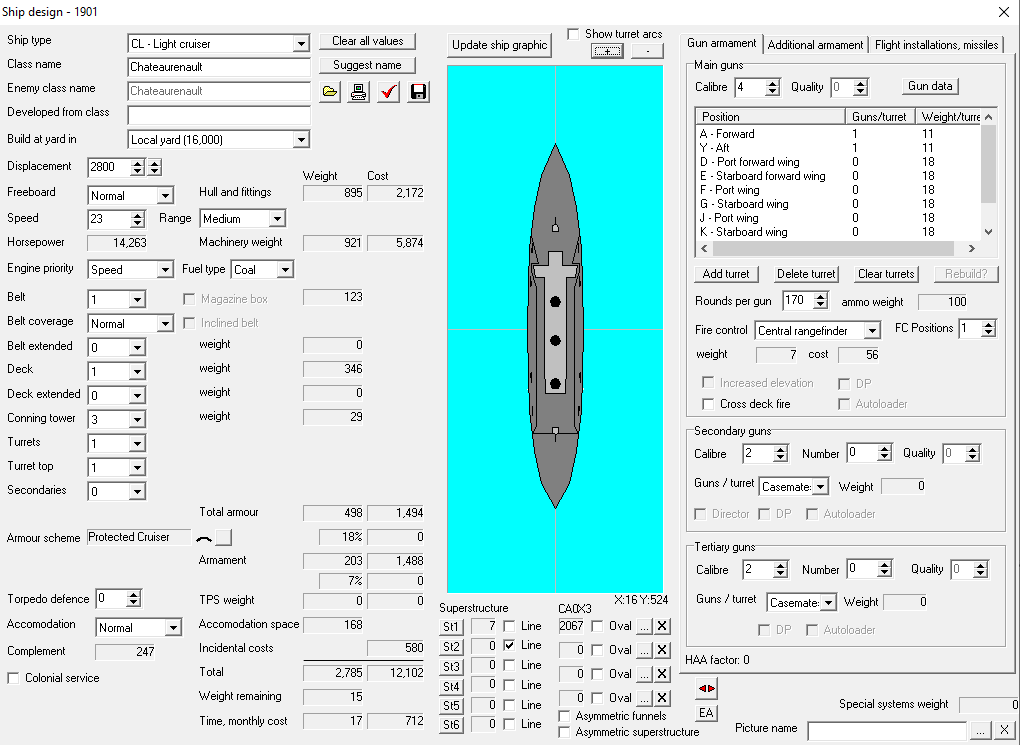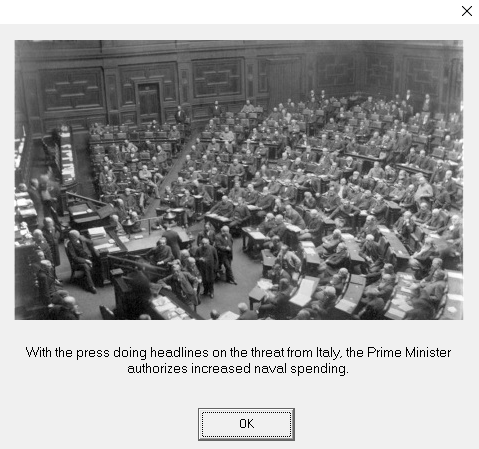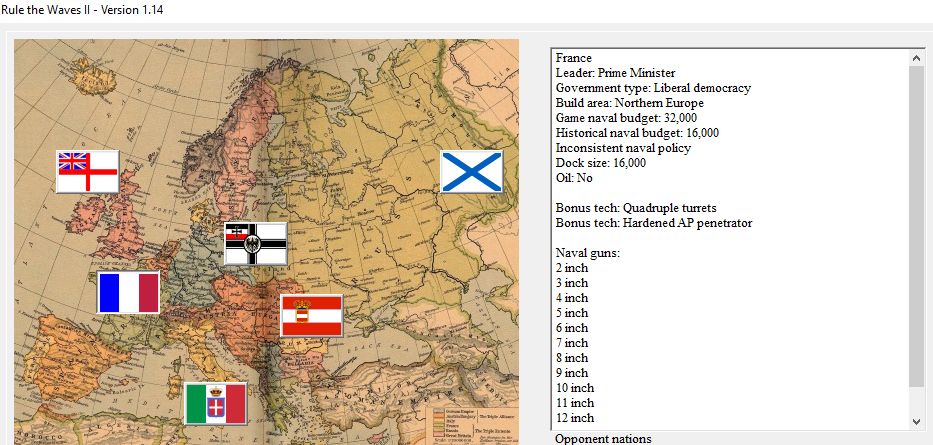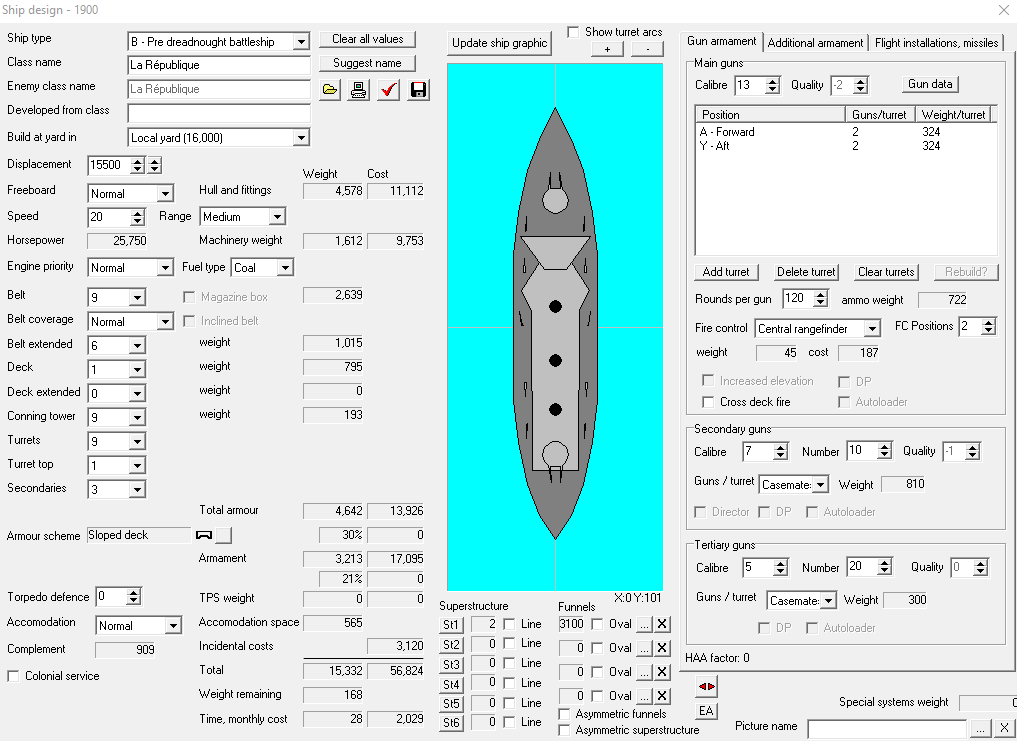Before diving into the month-by-month update structure to which Rule the Waves 2 lends itself, I realized based on some comments last week that I haven’t explained what Rule the Waves 2 is.
Rule the Waves 2 is a strategy wargame which covers, in roughly equal parts, the design and development of warships between 1900 and 1955, and battles using those ships. The two most important parts of the game are the ship design screen (which you’ve seen a few times already in the first entry in this series, and which you will see twice more today) and the battle interface (which has not yet come up). The strategic layer which glues the two together is primarily there to create reasons to design ships and to start wars in which the ships get used.
That’s pretty much the long and short of it. The game advances in one-month turns; battles play out in one-minute real-time simulation steps.
June 1900
Back to the game. Two fresh destroyers come down the ways, and our spies uncover details on a new class of Italian armored cruiser. Not much to worry about.

Much slower and much lighter than ours.
August 1900
Unlike historical France, this is not a democracy, but the weight of public opinion nevertheless leans toward bullying the Mediterranean. Another fellow is doing a Rule the Waves France playthrough right now, and is also bullying the Mediterranean. It seems to be working, but I also hate to be a copycat. I think we’ll keep our eye mainly on the Mediterranean, but we won’t disdain the chance to expand in Southeast Asia if it falls before us. (At the behest of a blog commenter—I’m running this in three places with three relatively active audiences, if I hadn’t mentioned that already.)
With an eye toward Mediterranean domination, the bulk of the navy moves to Marseilles. A squadron of destroyers stays on the northern coast.
October 1900
October sees a handy event. The Prime Minister makes a gaffe, so we exploit it for more money. This has the side effect of bringing war with Italy nearer, but with the increased budget, I order another Tage-class and push our research spending to the maximum permissible 12%. Worth it.
December 1900
A new government decides to raise expenditures on armaments. That’s good news for us. We lay down a new La République, to be named Suffren.
January 1901
The Gueydon-class cruiser Bruix enters service. Replacing her on the build list is one light cruiser and three destroyers.
Light cruisers are particularly important elements of the fleet. They serve as our eyes in fleet battles, typically deployed in an umbrella ahead of the battle line. Given the speed of our battleships and the size of their guns, holding our preferred range is important, and a robust scouting force of fast light cruisers will let us do that.
February 1901
Parliament votes to cut naval spending, upending our carefully-planned budget. We have enough of a cushion to run a deficit until some ships finish building, however, so that’s what we’ll do.
March 1901

A breakthrough in ship design! We can now build semi-dreadnoughts, ships with secondary batteries not dramatically smaller than their primary batteries.
That brings us into approximately the semi-dreadnought era. Pre-dreadnought battleships, with a small battery of heavy guns and a larger battery of quick-firing medium ones ones, were predicated on the idea that naval gunnery at long ranges was not possible. You had your big guns to punch through heavy armor, and a good number of smaller guns to wreck your target’s upper works and superstructure as the range closed, keeping up a high rate of fire.
Early on in the 20th century, advancements in rangefinding and fire control proved that this was not the case. Since your big guns could hit targets at long range, it made less and less sense to carry a lot of middleweight guns when you could instead spend that weight on your heavy ones, and deliver knockout blows from further away from your enemies. This update to the received wisdom on shipbuilding ultimately produced the dreadnought battleship.
The technological capability to build ships with, say, three centerline turrets with 12″ guns existed in 1900, but doctrine had not yet caught up. While most of the technologies we’ll develop in Rule the Waves are actually technological advancements, some (in particular, in the Ship Design tree) represent the development of new ways of thinking. We, as players with some historical knowledge, know that the dreadnought battleship is the way of the future, but our 1901-era French have not yet hit upon that idea, so the game sticks some limits on us to force us to stay in character.
April 1901
Spies report that the Italians have also figured out the heavy secondary battery. We’re keeping an eye on their shipbuilding, but they haven’t laid down any new battleships just yet. It appears they’re focusing on their wimpy armored cruisers.
May 1901
More intelligence reports from Italy: they’ll be commissioning a new light cruiser just after the New Year, and their current light cruiser class has a speed of 21 knots and belt armor of two inches. Their armor is heavier than our light cruisers’, but they can barely outrun our battleships, and our armored cruisers could easily run them down and have a massive firepower advantage.
Our Gueydons slot into the hierarchy of naval warfare right around where battlecruisers do a decade later. Battlecruisers made armored cruisers obsolete, by dint of their higher speed and heavy main armament—a battlecruiser could easily catch and outshoot an armored cruiser, and could easily outrun a battleship (whose armor tilts the fight in favor of itself).
The Gueydons to light cruisers are like battlecruisers will be to armored cruisers, in that they’re excellent light cruiser hunters—faster than other armored cruisers with heavier guns, faster than most light cruisers, and much more heavily armed. Too, as someone pointed out, they’ll make great experimental aircraft carriers someday.

One year in, the Italians have nearly caught up to us in naval budget. We’re closing the battleship gap, but won’t have our sixth ship until 1903. They’re building more armored cruisers, but ours are heavier.
June 1901
We may not get the chance to catch up, though. Italy looks to be making waves in Greece.

The Italians back down, but tensions rise.
July 1901
With tensions between France and Italy running high, we skip hosting an international regatta in favor of keeping the budget focused on shipbuilding.
The Italians raise their naval budget again.
August 1901
We catch a German spy. I briefly debate using the occasion to push for a higher budget, but decide instead to sweep it under the rug. Tangling with Germany would be unpleasant.
September 1901
A disarmament conference in the Hague ends with no concrete results, to my satisfaction.
October 1901
One light cruiser and three destroyers enter service.
We send a force to quell an uprising in China, which increases tension, but also raises the prestige of the French Navy.
One concrete suggestion from a reader was a cheaper (that is, expendable) class of light cruiser for commerce raiding. Enter the Chateaurenault class:

At 2800 tons, it’s a little more than half the displacement of our Tages. It doesn’t sacrifice much speed—at 23 knots, it’s still one of the faster light cruisers in current production, at least that I’m aware of—but has lighter armament and armor. It’s much cheaper than the Tages, too, so we can bulk out our fleet of light cruisers more quickly.
December 1901

Thanks to the newspapers, we get a little budget bump. Design studies on the Chateaurenault class are finished, so we order two with some of our current excess.
January 1902

Spies recently dispatched to America to see what one of the big-spender naval powers is up to bore their first fruit this month, giving us a blueprint for an American armored cruiser of the San Diego class. It isn’t much to write home about. The Gueydons remain clearly superior in weaponry, speed, and armor, as you might expect from ships with an extra 5,000 tons displacement or so.
It’s a good month for the French intelligence services generally. We hear that the Americans are building a Raleigh-class light cruiser with 3″ main guns, outmatched by even our cheap light cruisers. Austria-Hungary has commissioned two armored cruisers this month, and Italy has improved its armor-piercing shells.
February 1902

Spies recently dispatched to America now bear negative fruit. One of them gets caught.
As a consolation prize, we invent a number of new technologies this month, reducing the weight of our ship’s hulls and machinery and allowing us to build ships with secondary batteries in double turrets. Ocean, a La République, is coming off the ways in three months. I smell a new battleship design to take her place.
March 1902
The Japanese wish to buy a technology from us. I decide to sell it, given that we’ll shortly be paying the design expenses on a new battleship design.
Well, since we are paying the design expenses on a new battleship design.

The Trident-class battleship features the same four-gun 13″ main battery as the older Les Républiques, backed by a pair of two-gun 12″ wing turrets in the secondary battery. 12 4″ guns in turrets provide defense against small craft. Their armor protects them against their own guns between at least 5,000 and 9,000 yards, and possibly further out or in depending on gun data at those ranges.
Finally, they have a 22-knot speed, practically unheard-of in this era. Even the real-world HMS Dreadnought, still four years off, only managed 21, and that was with turbines rather than the triple-expansion engines we’re rocking.
Anyway, the upshot is that sufficiently fast heavy ships render armored cruisers obsolete, so there’s no real reason to build more Gueydons.
That brings us to a decision point. The Tridents are the largest ships we can build in our current docks. Should we focus on building a shipyard expansion or two over the next two years, building one Trident at a time, or build out the fleet more quickly by building two Tridents at once? A shipyard expansion costs 2,000 per month, I believe, so at this point in our game history, it’s just about equivalent to one battleship.
April 1902
Just as we prepare to render the armored cruiser obsolete, the monthly intelligence report indicates that Austria-Hungary, Great Britain, Japan, and Italy have either laid down or commissioned armored cruisers this month. Our spies in America steal the blueprints for another San Diego-class, which is of limited use to us given that we saw the same blueprint in January.
May 1902
The La République-class battleship Ocean is commissioned. One year from today, the last La République, Suffren, will join the fleet. Next month, the design studies on the Trident type will finish, and we can start producing one of those.
French researchers have developed reliable bursting charges, which will enhance the damage of penetrating hits. A trade mission to Great Britain yields important results: we developed the technology to build coastal submarines. Finally, we learned how to make 600-ton destroyers. A new design there will be in the offing early in the next entry. Speaking of, should we spend our small-ships budget on new destroyers or on some submarines? The coastal submarine design will work well for us, given our focus on the Mediterranean; each submarine costs a little more than half as much per month as the Fauconneau destroyers do (although the Fauconneaus are cheaper in absolute terms, taking fewer months to build).
The intelligence report is very busy this month: Germany commissions a pair of destroyers and a pair of battleships, Great Britain is concerned about its naval superiority and has increased its spending. (That’s their national special ability. Ours? Our government frequently changes its mind on fleet priorities. C’est la vie…) Italy has laid down a pair of light cruisers, but between what we have in service and what we have under construction, we still have a better light cruiser fleet.
Japan has at least two classes of armored cruiser in progress right now, one with 10″ main guns and another with a 20-knot speed and a 5″ armor belt, both of which are entirely outclassed by even our existing battleships, to say nothing of our future designs.
Two-Year Report: Diplomacy

Tensions continue to run high with Italy, our most likely foe in the next few years. Despite our efforts, the Austro-Hungarians continue to view us as friends.
Britain and Germany, the two do-not-touch powers, aren’t our biggest fans, but also don’t seem to have much motivation to come after us.
Two-Year Report: The Fleet

Here are the Mediterranean Current Naval Tonnage and Planned Naval Tonnage Rankings. Italy has about a battleship’s lead over us presently in the latter category, with the situation flipped in the former.
- FR 190,700
- IT 179,600
- AH 128,600
IT 238,300
- FR 222,100
- AH 164,100
Italy still holds a lead in battleship tonnage, and will continue to do so until at least one Trident enters service (which is two years and five months out from when we lay the first one down).
Their lead in the Planned Naval Tonnage category stems from a heavy investment in armored cruisers, to match the Austro-Hungarian plan. Should we could consider a class of inexpensive armored cruisers to match them? Compared to a Trident (which takes 29 months to build and costs about 2100 funds per month), a hypothetical 22-knot cruiser with 9″ main guns, a 5.5″ belt, and a turreted 5″ secondary battery would take 22 months to build and cost about 1,500 funds per month. That’s a little more than our current class of large light cruisers per month, and five months longer. These cruisers would be armed slightly below the standard of their peers, but armored similarly, and would have a speed advantage of a knot or two. I lean against the idea, myself, given that we have a fast class of battleship and a light cruiser class suitable for commerce raiding, but I figured I’d put it on the table.
Under construction right now, we have one La République, which will be finished in 11 months, a pair of Tages, which will finish between one and four months from now, and a pair of Chateaurenaults, which are about a year away, in addition to a single Fauconneau.
Our current budget surplus is 2,120 funds per month, which will be put into a Trident as soon as the design study finishes next month. Out of our total budget of 15,100 per month, maintenance on the fleet costs us 4,652 and construction costs us 6,315.
Don’t forget, when answering, that shipyard expansions are also on the table as options for spending our money.








